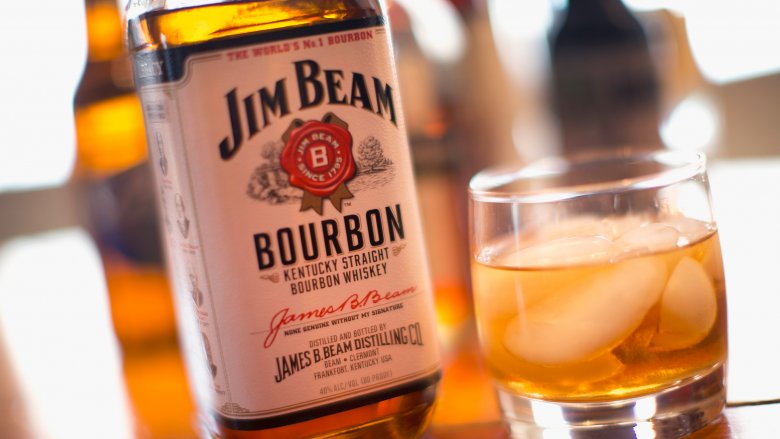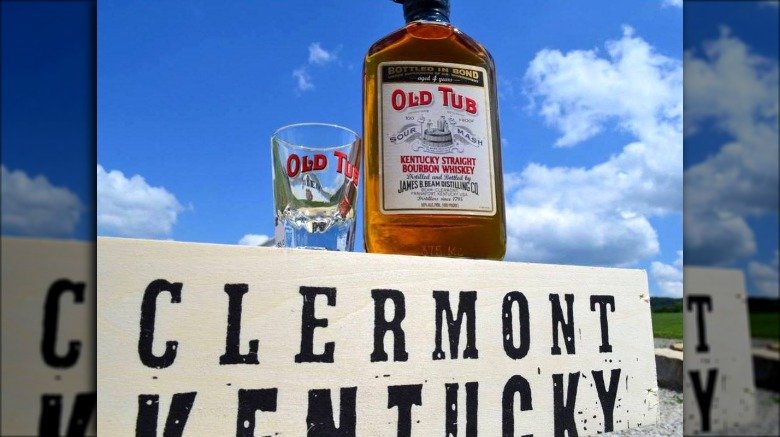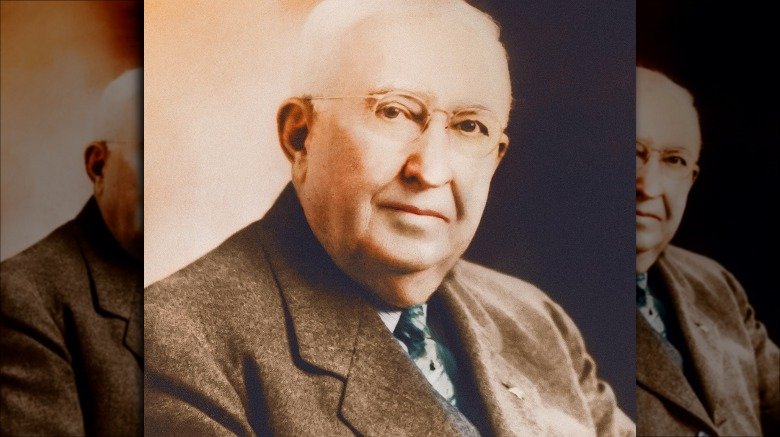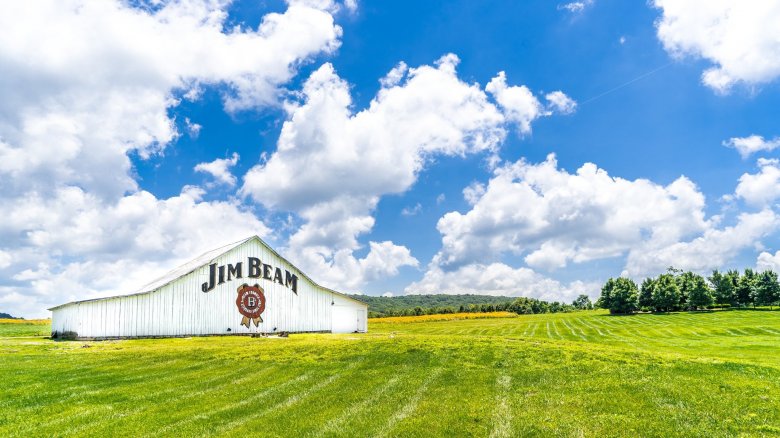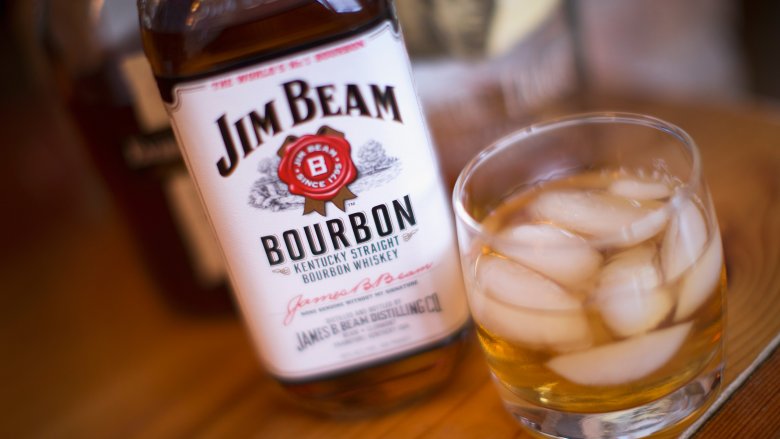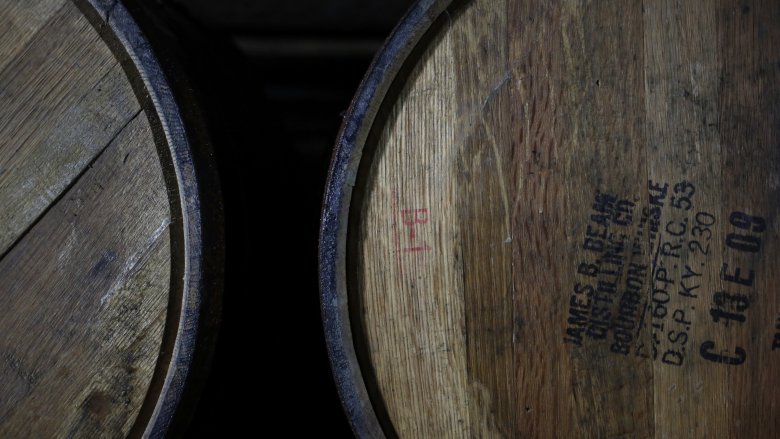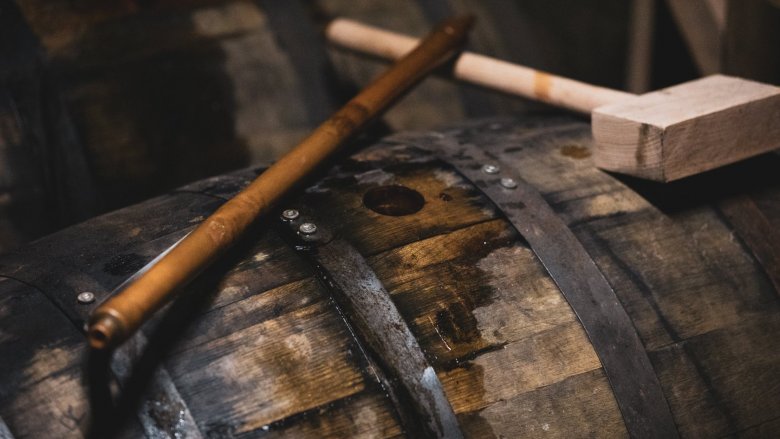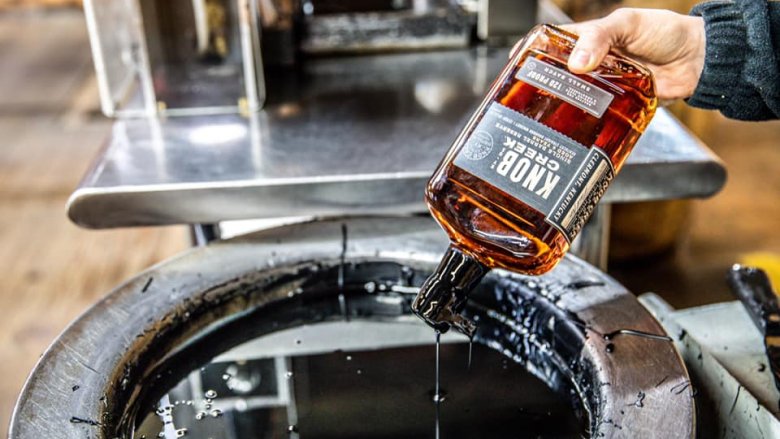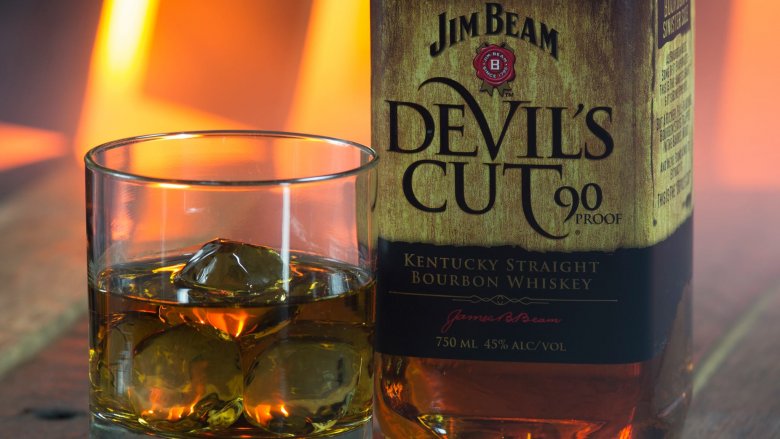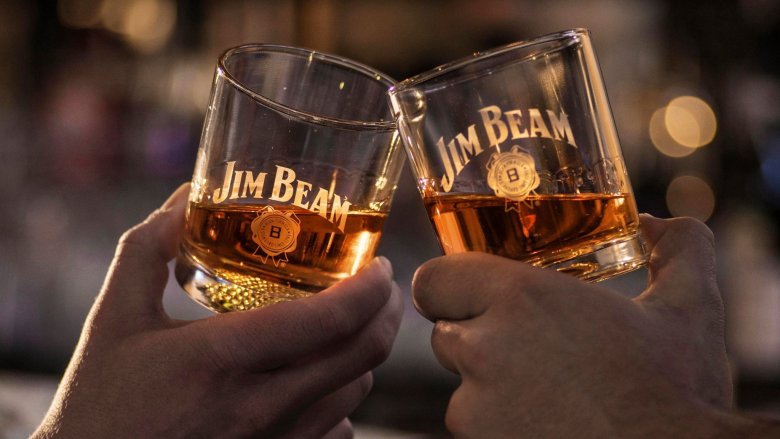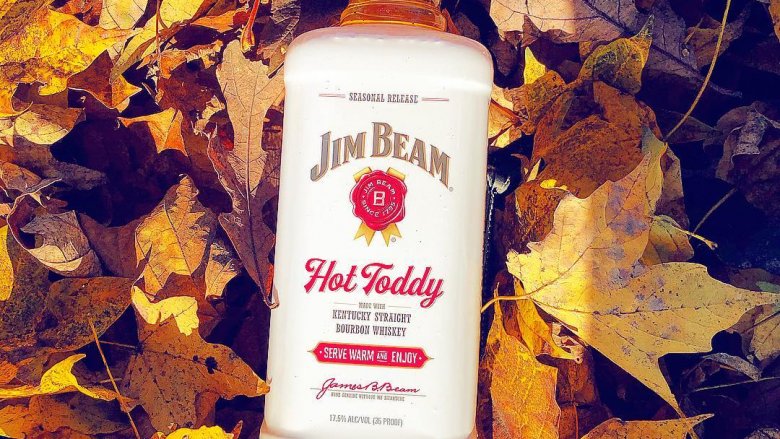The Untold Truth Of Jim Beam
Why does the world love Jim Beam? Because it's amazing without being pretentious, and a solid win at any bar without being insanely pricey. The lack of pretension is right in the name, after all — it may have been James B. Beam who got his signature on the bottle, but you can just call him "Jim."
These days, Jim Beam and the brands they produce are actually owned by Beam Suntory, Inc., and their headquarters are in Osaka, Japan. But they're still holding firm to their home-grown roots with their two distilleries in Kentucky, and that's smart — that's what made them the massive bourbon distiller they are today. According to Whiskey University, the same family has been making bourbon since 1795 — with a brief but fascinating interruption we'll talk about later.
A few centuries after Nicholas Boehm brought his family to a very young United States from Germany, changed his name to Beam, and tragically died before he saw his children learn the basics of fermenting, seven generations of the family have been heading up distilling in the Beam name. That's a pretty impressive legacy, even if you don't like bourbon... and who are we kidding? Of course you like it.
Daniel Boone had a hand in Jim Beam's start
The bourbon we all know and love may have been in production for a long, long time, but in the beginning, it looked pretty different — and Whiskey University says it sort of started with legendary frontiersman Daniel Boone. After Boone and company cleared their way through Kentucky, Jost Myers was handed 800 acres as a huge "thank you" for his role in the Revolutionary War. He passed that on to family, and part of that family was Jacob Beam.
Beam used his 100 acres well and started distilling right away, making "Old Jake Beam Sour Mash." He eventually purchased more acreage, and it was his son David who took Dad's family-sized distillery, expanded it, renamed it to the Old Tub Distillery, upgraded from pot stills to column stills, and enlisted the use of steamboats and railroads to sell their product far and wide. Not only were they among the first companies to use column stills, but they were also early into the practice of using charred barrels to age their bourbon.
Yes, there was a real Jim Beam
A few generations later came James Beauregard Beam, who was born in 1864 and who would become the most famous of the Beam family. (Yes, that's his signature on the bottles.) According to Whiskey University, he first saw his family's distillery torn to the ground in the chaos of Prohibition. During the years when making alcohol was illegal, he tried a few other businesses — like farming and quarrying — but he was so bad at both that people in the town said if he opened a funeral home, everyone would stop dying.
But he only had to be good at one thing, and he was. Jim Beam was 70 years old when Prohibition ended, and while that might seem like a ripe old age to start a business at, he wasn't actually starting a new one... he was picking up right where they left off. He and his son started making Old Tub again — along with a couple of other labels — and it was all done under the James B. Beam Distilling Company.
Beam died in 1947, and he's buried in a Bardstown, Kentucky cemetery close to his namesake distillery. Unfortunately, he never got to see his son release Jim Beam Black in his honor (that hit the market in the 1950s), and he never got to see his induction into the Kentucky Bourbon Hall of Fame. That happened in 2002, and he was the third of many family members to be inducted.
Rome wasn't built in a day, but Jim Beam was built in 120
In 2018, Jim Beam marked the 85th anniversary of the end of Prohibition with the release of Jim Beam Repeal Batch, a bourbon they announced had been directly inspired by the same bourbon they made at the end of the country's unfortunate dry spell. And the story of how it all happened is pretty cool.
According to the story, when it was announced that Prohibition was going to be repealed, the nation celebrated — quite literally — with the exception of one man: the 70-year-old Jim Beam. He wanted his first drink to be one made from his family's recipes at his family's distillery, but there was nothing left but ruins. So, he recruited a handful of friends and family and set to work, rebuilding the entire thing in a record 120 days. That's just a few months to go from nothing to distilling again, and that's not just dedication, that's some seriously impressive teamwork that shows nothing brings people together quite like the promise of a good drink.
You're drinking the same Jim Beam your great-grandparents did
In case you're not familiar with the distilling process, here's a quick lesson: It's all about the yeast. Take Four Roses. They have five different yeast strains, says First We Feast, and each one is responsible for imparting a different flavor. One's herbal, one's spicy, one's fruity... you get the idea.
So what about Jim Beam's yeast?
According to bourbon historian Chuck Cowdery, Jim Beam's grandson Booker Noe shared exactly where their yeast came from originally. While Beam was rebuilding the family distillery, he went out on his back porch one night and caught a strain of wild yeast. That's it! And that? It's pretty cool. How, exactly, do you catch wild yeast? According to Bootleg Biology, it's pretty easy. It's all around us all the time, and all you need to do is create a starter mix, put it in a jar sealed with cheesecloth, and wait. Yeast!
Jim Beam is still using that same yeast strain, and that means the bottle sitting on your counter right now tastes pretty much the same as a bottle that was distilled decades ago. Beam says the yeast is such an important part of their process that Jim Beam started a tradition of taking some home on the weekends — just in case something catastrophic happened while he wasn't in the distillery — and they still do that today.
The Jim Beam warehouses are often destroyed
Taking some yeast home every weekend seems like it might be extreme, but when a rampaging mob of temperance-loving hooligans tears down your entire family business, it's understandable that you might be a little wary. And strangely, Jim Beam has had a lot of unfortunate accidents in recent times.
In 2003, Firehouse reported a warehouse fire destroyed 800,000 gallons of their bourbon while surrounding warehouses were spared from the blaze thought to have been started by a lightning strike.
Lightning struck Jim Beam again in 2015, when The Independent reported that winds whipped the alcohol-fueled fire into a blazing tornado that was literally sky-high. Another 800,000 gallons of bourbon were lost, and that wasn't the end.
It happened yet again in July 2019, when, Salon reported, yet another lighting strike hit a Kentucky warehouse and destroyed 45,000 barrels (or, in other words, about 6 million bottles' worth of bourbon). That's staggering, but Jim Beam made it clear that was a relatively small quantity of young bourbon. Overall, they have 126 warehouses and about 3.3 million barrels at any time.
To be fair, it's not just Jim Beam's bourbon warehouses that seem plagued with misfortune. O.Z. Tyler Distillery lost one in a 2019 thunderstorm, Barton 1792 Distillery had an entire warehouse collapse in 2018, a Silver Trail distiller was killed in a 2015 explosion, Wild Turkey had a fire in 2000, and Heaven Hill lost a warehouse in a fire in 1996.
The Jim Beam fires had tragic consequences
Losing millions of bottles of bourbon hasn't been the only consequence of Jim Beam's warehouse fires — the environmental cost has been staggering. The Independent reported that the blaze caused by the 2015 lightning strike was largely contained because of the warehouse's close proximity to a creek, but that also meant the creek became contaminated by alcohol spills and killed a huge amount of wildlife. Jim Beam shouldered the clean-up costs, and when it happened again in 2019, the consequences were devastating.
Barrels upon barrels of bourbon were dumped into the Kentucky River, and according to CNN, the resulting alcohol plume stretched a shocking 23 miles. Containment systems were set up to try to minimize the spread and aeration devices were set up to try to prevent the river's wildlife from suffocating, but just days after the fire, the river was full of dead fish and aquatic life.
Jim Beam is the reason we have small batch bourbon and whiskey
Jim Beam might be massive, but surprisingly, they're also the reason we can enjoy small batch whiskey and bourbon.
The small batch liquor craze is fairly new, and it's no wonder it took off. It lets people feel like they're enjoying something that's exclusive, that's not going to be around forever, and that not everyone will get to try — even though, Whiskey Raw notes, there's no actual definition for what makes something "small batch," and anything can actually be labeled that way.
Where does Jim Beam come in? It was Beam Master Distiller Booker Noe who came up with the idea in 1992. Noe — who was the grandson of Jim Beam, notes Whiskey Advocate — had a track record of steering the company down the road they had been on for decades and resisting veering off into things like vodka. He was the one who separated out certain barrels for bottling (instead of just dumping everything into one giant batch), and kicked off the small batch movement with Booker's True Barrel Bourbon, Basil Hayden, Baker's, and Knob Creek.
Noe died in 2004, and Jim Beam's statue of him is now a must-see tourist destination.
Jim Beam defied science to release their Devil's Cut
Distilling has been around for a long, long time, and it was originally associated with ancient beliefs in the principles of alchemy. (And, if you ask us, turning things like barley and corn into elixirs that make life better, well, if that's not alchemy we don't know what is.) VinePair says some of the earliest records of distillation go back to as early as 800 BC, and given that it's been around that long, you might think we know all there is to know. Not so, says Jim Beam, and in 2011 they announced the release of something completely innovative: Devil's Cut.
First, a little distilling science (and legend). When spirits age, part of the liquid is lost to evaporation and absorption into the porous wood of the cask it's being aged in. There's a lot of factors that determine just how much is lost — things like temperature, humidity, and even the cask's elevation in the warehouse — but whatever's gone? That's the angel's share, and the oft-told story is that for every barrel of spirit, the angels need a taste.
And that's where Devil's Cut comes in. Once Beam empties their casks, there's some liquid that's still trapped in the porous wood. With a proprietary (i.e. top secret) process, they've figured out how to extract that bourbon. It's mixed with extra-aged bourbon and bottled, so when you're drinking it, you're drinking bourbon swiped from under the noses of the angels.
What makes Jim Beam bourbon and not whiskey?
So what makes Jim Beam bourbon, and why is it not just Jim Beam whiskey? Technically, it is, and here's the deal.
Every bourbon is whiskey. But not all whiskey is bourbon.
There's a series of guidelines that need to be met in order for something to be called bourbon, and it's surprisingly stringent. First, it needs to be made from at least 51 percent corn, and that means it's going to be sweeter than whiskeys (that are made with less corn). The only additive bourbon makers can use is water, while whiskey distillers can add other things — like color and flavorings — to their product. Bourbon has to be aged in new, charred oak barrels, and that's a big one. Many whiskey and scotch distillers age their product in barrels that have already been used — often by bourbon — in order to change the flavor.
And finally, bourbon has to be both distilled and aged in the U.S. To go one step further, it can't be Kentucky Straight Bourbon — like Jim Beam is — unless it's distilled and aged (for at least two years) in Kentucky. Now you know!
What "sour mash" really means
There's a lot of lingo that goes along with distilling, and one you've probably heard — sometimes on labels, sometimes hotly debated among a certain type of person who likes to argue these things — is sour mash. And it absolutely doesn't mean that it's sour — it's referring to the process that's used to start, well, the process.
Before you even get to distillation, there's fermentation. The Whiskey Still Company says that starts with fermenting a batch of grains with water and yeast. That's eventually what produces the alcohol that's separated during distillation and sometimes, after the distillation process, some of the spent mash is saved and added to the next batch of mash. (It's the same way you make sourdough breads, and that's where the name comes from.)
Why? Because reusing part of the mash makes it easier to control things like bacteria growth and flavor, and it also helps keep the batches consistent. It's incredibly common, and in case you've ever noticed a product that's labeled "Tennessee whiskey," it's legally got to be sour mash. Jim Beam doesn't do it all the time, but when they do, you'll see it on the label.
Jim Beam is a legitimate option for fighting off the sniffles
If you tend to reach for the orange juice or the chicken soup when you're fighting off a cold, there's good news for Jim Beam lovers: Science says it can help, too.
A hot toddy might be something of an old-school cold remedy, but Mic says that there actually is something to this one. Yay!
Research has shown that the magical mixture of the hot toddy — whiskey or bourbon, honey, lemon juice, and hot water, at its most basic — actually does help alleviate even the worst symptoms of a cold. The heat of the drink helps relieve congestion (especially if you inhale the delicious steam coming from your mug), the lemon juice thins mucus and relieves that aching pressure you sometimes get in your head, and the honey is great for a sore throat.
What about the Jim Beam? The boozy part of the concoction has been linked to helping relieve those aches and pains — it's why many over-the-counter cold medicines have a bit of alcohol — and, if you only have a dash, it can help you fall asleep faster and snooze through your cold. See: alchemical magic.
Keep a bottle of Jim Beam in your kitchen and your bar
Most of us might enjoy a glass of Jim Beam neat, on the rocks, or in a cocktail, but if you're only drinking it, you're seriously missing out. There's a ton of other things you can do with it, and you might just want to keep a bottle in your kitchen cupboard. You know, as an ingredient.
If you ever marinade anything, you'll want to try fleshing your marinade out with a 1/4 cup (or so) of Jim Beam. It's brilliant with other ingredients like honey, soy sauce, dry or Dijon mustard, garlic, ginger, brown sugar, or Worcestershire sauce, and honestly, you only need a couple of those (as you see fit!) to whip up a sweet, boozy marinade that's just as good on chicken as it is on steak. Throw those on the grill and you've got a dinner to talk about, especially if you whip of a Jim Beam-based barbecue sauce to go with it. Stir up your favorite mix of ketchup, soy sauce, hot pepper powder, vinegar, and Sriracha, then add a healthy dose of Jim Beam before you simmer and reduce it. Win!
It's great for baking, too — especially the apple, vanilla, and Red Stag varieties of Jim Beam. Brush the tops of your cupcakes with it, pour a dash in when you're whipping up some frosting, and don't just top it with that frosting, inject it right into the center. Brilliant, right?
